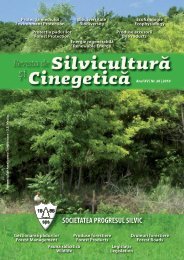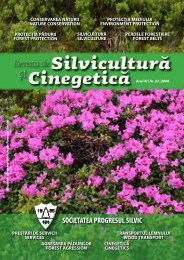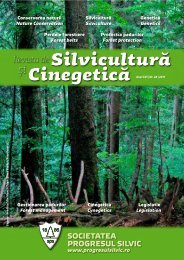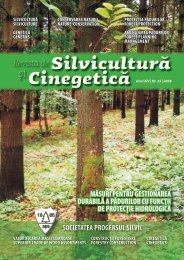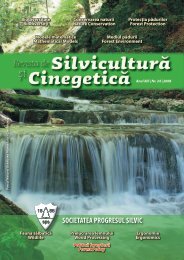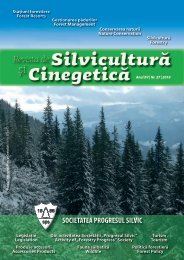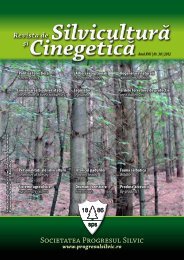Silviculture and Cinegetics Review - Societatea Progresul Silvic
Silviculture and Cinegetics Review - Societatea Progresul Silvic
Silviculture and Cinegetics Review - Societatea Progresul Silvic
You also want an ePaper? Increase the reach of your titles
YUMPU automatically turns print PDFs into web optimized ePapers that Google loves.
FORESTRY BELTS SILVICULTURE AND CINEGETICS REVIEW XVII/30/2012<br />
albus<br />
Relief: P-plain; Pt-plateau, H-hill, Texture: H-heavy, M-medium, L-light; pH: la-low acidity; Ca-carbonates; Humid.-humidity: h-humid, d-dry; Alt.-<br />
altitude; SF-Superficial; Sk- Skeleton; UF-unstable (fixator)<br />
Table 3.b. Species ecology<br />
No. Species Exp.<br />
Biological features<br />
Soil<br />
Prot.<br />
Closure<br />
massive<br />
state<br />
(year)<br />
Longevity<br />
H (m) Increm.<br />
Crw. Sistemul<br />
Leaves<br />
Temper.<br />
Dens. radicelar<br />
Cd Pers<br />
0 1 19 20 21 22 23 24 25 26 27 28 29<br />
Main species<br />
1 Pinus nigra var. austriaca S 30 medium dense high light - Pers. M 5-10 70(80) yr<br />
2 Ailanthus altissima S 15-20 fast rare rich light c H 3 low<br />
3 Prunus avium S 20-25 fast medium rich light c G 3 medium<br />
4 Fraxinus excelsior N 40 fast lighty high humid - light c L 3 high<br />
Secondary species<br />
5 Acer campestre E-V 15-20 medium dense rich half-shadow c H 3 100 yr<br />
6 Fraxinus ornus S 5-10 slow medium<br />
rich /<br />
high<br />
light c H 3 high<br />
7 Sorbus aucuparia E-V 5-10 medium medium rich half-light c H 3 high<br />
8 Salix capraea E-V 10 fast rară rich light c M 2 low<br />
High shrubs<br />
9 Eleagnus angustifolia S 7-8 fast rară rich light c H 3 high<br />
10 Hippophae rhamnoides S 2-3 fast rare very rich light c H 3-4 high<br />
11 Juniperus communis S 5 slow dense rich light Pers. H 3 high<br />
12 Corylus avellana N 4-5 fast dense rich half-light c H 3 high<br />
Small shrubs<br />
13 Prunus spinosa S 3-5) medium dense profound shadow c H 3 high<br />
14 Paliurus spina christi S 1-3 slow dense rich shadow c H 3-5 medium<br />
15 Cornus sanguinea E-V 3-4 medium dense rich half-shadow c H 8-10 medium<br />
16 Colutea arborescens S 4 slow dense rich light c M 3 medium<br />
17 Rosa rugosa S-V fast medium rich light c M 3 medium<br />
18 Symphoricarpus albus N medium dense rich light c M 3 medium<br />
Exp.: slope exposure; H: height; Incr: increment; Crw.dens: crown desity; Temp.: temperament; Cd: caducous; Pers: persistent; Soil Prot.: Soil protection<br />
(H-high, M-medium, L-low)<br />
Plant health of these species is inappropriate:<br />
- All species present valley inclines, even resinous<br />
anchored by pickets, due to padding ground<br />
movement;<br />
- Rare 3-4 m hight pine, planted before this study, has<br />
dyied in proportion of approx. 90%, due to adaptation<br />
problems typical for plantations with large seedlings<br />
(grown in special nurseries under controlled<br />
conditions of humidity) transplanted in very difficult<br />
conditions (in hot summer, in open field without<br />
shelter, without daily watering etc.); moreover this<br />
species of acidic soil does not correspond to the<br />
carbonated soils;<br />
- Rare 3-4 m hight Norway spruce planted in 2009 has<br />
dried only in proportion of approx. 10%, but its<br />
keeping is not certain, the needles are slightly wilted<br />
in March 2010, partially covered by black deposits (of<br />
uncertain origin, probably before planting because it is<br />
not present in other species); it still requires special<br />
attention (especially by maintaining soil moisture at<br />
an optimum level), because spruce do not preffer<br />
hydromorphic or compact carbonated soils.<br />
- The small to medium deciduous species are more<br />
resistant to planting, so it is expected that they will<br />
better survive; in March 2010, being out of the<br />
growing season, seedlings provide little indication of<br />
of their health status.<br />
7. Description of the stationary<br />
The ground waves are graded as "Regions of hills of<br />
the sessile oak <strong>and</strong> common oak subareas<br />
"stationary group GS 139 - embankment slopes<br />
consisting of mixtures of soil <strong>and</strong> rock, with s<strong>and</strong>yloamy<br />
to clay texture <strong>and</strong> variable content of skeleton<br />
(MAPPM, 2000 - technical st<strong>and</strong>ards for<br />
composition,schemes, <strong>and</strong> technology of forest<br />
regeneration <strong>and</strong> afforestation of degraded l<strong>and</strong>).<br />
On the waves of ground from Stupini erosion<br />
manifests itself as drops of water from rainfall <strong>and</strong><br />
water runoff on slopes.<br />
The classification by classes of degradation<br />
(Miulescu, Tăbăcaru, 1963), they fall in the<br />
moderatesecond degree erosion (E2), with rare<br />
runoffs, cracks <strong>and</strong> with superficial l<strong>and</strong>slides.<br />
The relatively small surface of the ground waves, the<br />
mosaic character of the soils used as fillers, the<br />
manifestation on reduced surfaces of runoffs <strong>and</strong><br />
94



